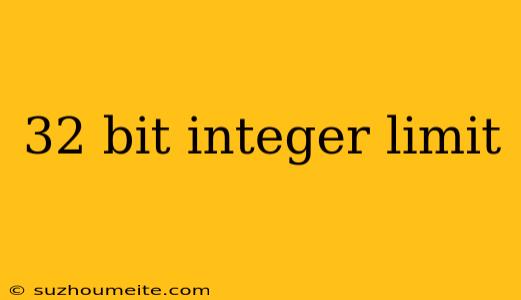The 32-bit Integer Limit: Understanding the Constraints of Integer Data Type
In computer science, integers are a fundamental data type used to represent whole numbers. However, like any other data type, integers have their limitations. One of the most significant constraints of integer data type is the 32-bit integer limit.
What is the 32-bit Integer Limit?
The 32-bit integer limit refers to the maximum value that can be represented by a 32-bit signed integer. In binary representation, a 32-bit integer is represented by 32 bits (0s and 1s), which can be divided into two categories:
- Signed Integers: The most significant bit (MSB) represents the sign of the number (0 for positive and 1 for negative). The remaining 31 bits represent the magnitude of the number.
- Unsigned Integers: All 32 bits represent the magnitude of the number, and there is no sign bit.
The maximum value that can be represented by a 32-bit signed integer is 2,147,483,647, and the minimum value is -2,147,483,648. For unsigned integers, the maximum value is 4,294,967,295.
Consequences of the 32-bit Integer Limit
The 32-bit integer limit has significant implications in various areas of computer science and programming:
Data Storage and Retrieval
When dealing with large datasets, the 32-bit integer limit can lead to data truncation or overflow, resulting in inaccurate results or errors. This is particularly problematic when working with big data or scientific applications that require precise calculations.
Memory Allocation and Management
In programming languages, the 32-bit integer limit can affect memory allocation and management. For instance, when allocating an array of integers, the maximum size of the array is limited by the 32-bit integer limit, which can lead to memory fragmentation and performance issues.
Performance and Optimization
In terms of performance, the 32-bit integer limit can impact the efficiency of algorithms and data processing. When working with large integers, the processor needs to perform additional operations to handle the overflow, leading to slower execution times.
Security and Vulnerabilities
The 32-bit integer limit can also lead to security vulnerabilities, such as integer overflow attacks. When an attacker manipulates an integer value to exceed the 32-bit limit, it can cause the program to behave unexpectedly, leading to potential security breaches.
Overcoming the 32-bit Integer Limit
While the 32-bit integer limit is a significant constraint, there are ways to overcome it:
Using 64-bit Integers
Many modern systems and programming languages support 64-bit integers, which can represent much larger values (up to 18,446,744,073,709,551,616).
Using Arbitrary Precision Arithmetic
Libraries and frameworks, such as GNU Multiple Precision Arithmetic Library (GMP), provide arbitrary precision arithmetic, allowing for the representation of extremely large integers.
Using Alternative Data Types
In some cases, using alternative data types, such as floating-point numbers or strings, can help circumvent the 32-bit integer limit.
Conclusion
The 32-bit integer limit is a fundamental constraint of integer data type that has significant implications in various areas of computer science and programming. Understanding the consequences of this limit is crucial for developing efficient, accurate, and secure software systems. By using 64-bit integers, arbitrary precision arithmetic, or alternative data types, programmers can overcome the 32-bit integer limit and create more robust and reliable software applications.
